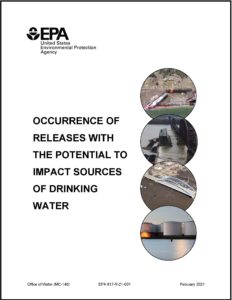EPA Publishes Report on Occurrence of Spills and Releases to Source Water
 EPA’s Water Security Division has published a report entitled, “Occurrence of Releases with the Potential to Impact Sources of Drinking Water.” This document is intended for use by the drinking water sector to better understand the risk of potential spills and releases and inform community water system (CWS) risk and resilience assessments, as required by Section 2013 of America’s Water Infrastructure Act (AWIA). The report provides some examples of significant source water contamination incidents that occurred from 2010 to 2019; information about previous research and release tracking databases; and shares the methodology, data analysis, findings, and recommendations from a study to characterize and categorize releases to CWS drinking water sources that were reported to the National Response Center, and take action to prepare for potential spills and releases. The report demonstrates that:
EPA’s Water Security Division has published a report entitled, “Occurrence of Releases with the Potential to Impact Sources of Drinking Water.” This document is intended for use by the drinking water sector to better understand the risk of potential spills and releases and inform community water system (CWS) risk and resilience assessments, as required by Section 2013 of America’s Water Infrastructure Act (AWIA). The report provides some examples of significant source water contamination incidents that occurred from 2010 to 2019; information about previous research and release tracking databases; and shares the methodology, data analysis, findings, and recommendations from a study to characterize and categorize releases to CWS drinking water sources that were reported to the National Response Center, and take action to prepare for potential spills and releases. The report demonstrates that:
- Releases to sources of drinking water occurred at an average rate of 393 releases per year over a 10- year study period;
- Some CWS are at substantially greater risk of releases to their source water; and
- CWSs should use the Emergency Planning and Community Right to Know Act (EPCRA) Tier II chemical inventory data (provided by AWIA Section 2018) to conduct an inventory of facilities that could release a harmful substance into their source water.
For reference, AWIA Section 2018 amended EPCRA to require that community water systems (1) receive prompt notification of any reportable release of an EPCRA extremely hazardous substance or a Comprehensive Environmental Response, Compensation, and Liability Act (CERCLA) hazardous substance that potentially affects their source water, and (2) have access to EPCRA Tier II information (i.e., hazardous chemical inventory data).
For more information, visit EPA’s website and download and read the report here.

